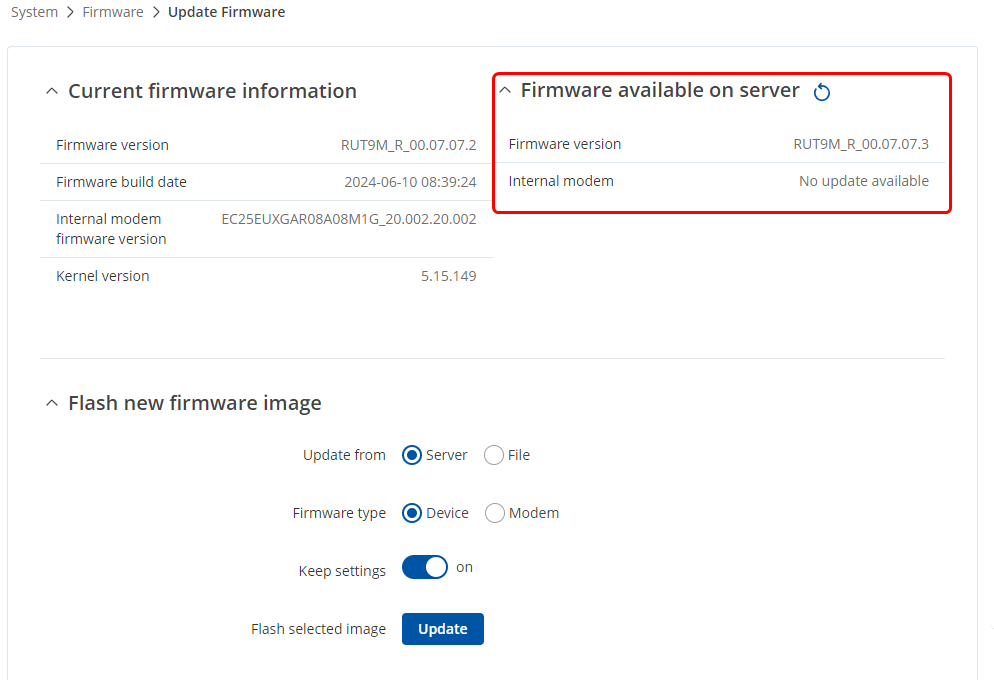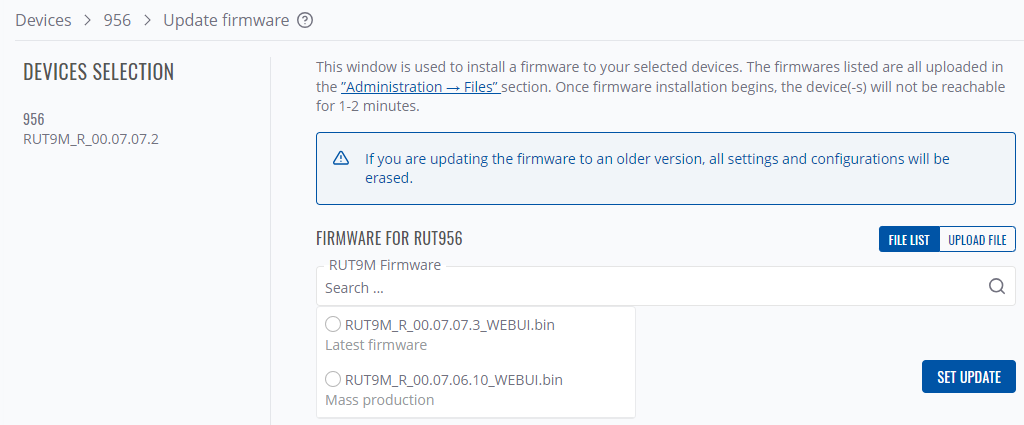RutOS and TSWOS firmware update: Difference between revisions
No edit summary |
No edit summary |
||
| Line 24: | Line 24: | ||
===Firmware update through WebUI=== | ===Firmware update through the WebUI=== | ||
The WebUI is the user-friendly graphical interface of the device. To update the firmware through the WebUI, navigate to the '''System -> Firmware -> Update''' '''Firmware''' page. This page allows you to check the current firmware version of the device and update the firmware either from a local file or directly from the server. If you wish to update the firmware from the server, your RUT, TRB, or TSW device must have internet access. If you choose to manually upload a firmware file, internet access on the router is not required. | The WebUI is the user-friendly graphical interface of the device. To update the firmware through the WebUI, navigate to the '''System -> Firmware -> Update''' '''Firmware''' page. This page allows you to check the current firmware version of the device and update the firmware either from a local file or directly from the server. If you wish to update the firmware from the server, your RUT, TRB, or TSW device must have internet access. If you choose to manually upload a firmware file, internet access on the router is not required. | ||
| Line 46: | Line 46: | ||
Once the update is started, make sure not to power off the device. Wait until the device reboots and becomes accessible again. | Once the update is started, make sure not to power off the device. Wait until the device reboots and becomes accessible again. | ||
===Firmware update through the RMS=== | |||
The Teltonika RMS platform can also be used to update the device's firmware. To update the firmware for device(s) selected from your device table, go to the RMS web page. In the left sidebar panel, navigate to Management → Devices and click on the Devices submenu. Then, move your mouse pointer to the top control Actions menu and select Update firmware (Actions → Update firmware). | |||
[[File:Rms fw 1.1.png|border|class=tlt-border]] | |||
After pressing the "Update firmware" button, you will be redirected to another page where you can choose to either upload the firmware file manually or download it from the server, just like in the WebUI. | |||
[[File:Rms fw 2.png|border|class=tlt-border]] | |||
When the update starts, your device will appear offline in RMS because it will be rebooting. The device may be unreachable for up to 1-2 minutes. | |||
Revision as of 09:00, 11 July 2024
Main Page > FAQ > Other Topics > RutOS and TSWOS firmware updateIntroduction
Having up-to-date firmware on your networking devices is crucial for several reasons. One of the most important is security. Firmware updates often include patches for known vulnerabilities that could be exploited by hackers. By keeping your firmware updated, you protect your network from potential security breaches. Additionally, updates can introduce new security features and protocols, further enhancing the overall security of your network.
Performance is another key reason to keep your firmware current. Updates often contain improvements and optimizations that can make your devices run more efficiently. This can result in faster data transfer speeds, better handling of network traffic, and overall improved performance of your network.
Firmware updates can also fix bugs and other issues that may affect the stability and functionality of your networking devices. These fixes can resolve connectivity problems, compatibility issues with other devices or software, and other operational hiccups that might otherwise disrupt your network's performance.
Finally, new features and capabilities are sometimes added through firmware updates. These can enhance the functionality of your networking devices, offering you new tools and options that can improve your network management and user experience.
This article outlines the process of updating the firmware on Teltonika Networks routers, gateways, and managed switches.
Prerequisites
There is not much preparation needed. If you have a Teltonika Networks device running on RutOS or TSWOS and an end device with internet access, you are fully prepared to update the firmware.
Firmware update
When it's time to update the firmware, it's important to know how to do it. There are a few different ways to update the firmware: through the WebUI, Teltonika RMS, or using the command line. In this article, we will describe all three methods.
Moreover, you have the option to initiate the firmware update by either manually uploading the firmware file or downloading it from the server. If you choose to upload the firmware file manually, you must know where to download the firmware file. All the latest and mass production firmware files can be found here. It's best to regularly check this page if you want to always have the latest firmware available. Additionally, each device has its own firmware page, where you can find all the available firmware files specific to that device, along with a changelog that describes details what was added, fixed, or improved in each firmware version. For example, you can find all available firmware versions and the changelog for the RUT956 here.
Additionally, starting from the RutOS 7.7 firmware version, firmware update notifications have been added to the router WebUI, making it easier for you to know when the latest firmware is available.
Firmware update through the WebUI
The WebUI is the user-friendly graphical interface of the device. To update the firmware through the WebUI, navigate to the System -> Firmware -> Update Firmware page. This page allows you to check the current firmware version of the device and update the firmware either from a local file or directly from the server. If you wish to update the firmware from the server, your RUT, TRB, or TSW device must have internet access. If you choose to manually upload a firmware file, internet access on the router is not required.
If your networking device has internet access, in the firmware update page, in the "firmware available on the server" section, you will be always be able to see which firmware is the newest one.
To start the firmware update, you only need to choose wheter you want to upload firmware file manually or retrieve it from the server, also choose wheter you want to keep all the settings after firmware update or not.
When you upload a firmware image, the device will have to verify the validity of that image. If the verification was successful, you will be redirected to window with a message such as this:
This means that the uploaded firmware image is compatible with your device. The indication also displays the file's Checksum. A checksum is a sequence of hexadecimal symbols generated after running an algorithm called a cryptographic hash function on a file. Calculating a checksum and comparing it with the one provided by the file source can be used as a file authenticity check method.
If everything is in order, you can click the Proceed button to begin the update or click Cancel to abort.
On the other hand, if the uploaded a firmware file that is incompatible with your device, you will see an indication such as this:

Once the update is started, make sure not to power off the device. Wait until the device reboots and becomes accessible again.
Firmware update through the RMS
The Teltonika RMS platform can also be used to update the device's firmware. To update the firmware for device(s) selected from your device table, go to the RMS web page. In the left sidebar panel, navigate to Management → Devices and click on the Devices submenu. Then, move your mouse pointer to the top control Actions menu and select Update firmware (Actions → Update firmware).
After pressing the "Update firmware" button, you will be redirected to another page where you can choose to either upload the firmware file manually or download it from the server, just like in the WebUI.
When the update starts, your device will appear offline in RMS because it will be rebooting. The device may be unreachable for up to 1-2 minutes.





